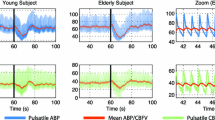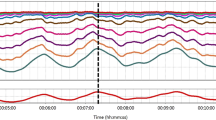Abstract
Cerebral autoregulation in healthy humans was studied using a novel methodology adapted from Bendat nonlinear analysis technique. A computer simulation of a high-pass filter in parallel with a cubic nonlinearity followed by a low-pass filter was analyzed. A linear system transfer function analysis showed an incorrect estimate of the gain, cut-off frequency, and phase of the high-pass filter. By contrast, using our nonlinear systems identification, yielded the correct gain, cut-off frequency, and phase of the linear system, and accurately quantified the nonlinear system and following low-pass filter. Adding the nonlinear and linear coherence function indicated a complete description of the system. Cerebral blood flow velocity and arterial pressure were measured in six data sets. Application of the linear and nonlinear systems identification techniques to the data showed a high-pass filter, like the linear transfer function, but the gain was smaller. The phase was similar between the two techniques. The linear coherence was low for frequencies below 0.1 Hz but improved by including a nonlinear term. The linear + nonlinear coherence was approximately 0.9 across the frequency bandwidth, indicating an improved description over the linear system analysis of the cerebral autoregulation system.








Similar content being viewed by others
References
Aaslid, R., K. F. Lindegaard, W. Sorteberg, and H. Nornes. Cerebral autoregulation dynamics in humans. Stroke 20:45–52, 1989.
Bendat, J. S. Nonlinear Systems Techniques and Applications. New York: Wiley, 1998.
Bendat, J. S., and A. G. Piersol. Random Data Analysis and Measurement Procedures (4th ed.). New York: Wiley, 2010.
Claassen, J. A. H. R., B. D. Levine, and R. Zhang. Dynamic cerebral autoregulation during repeated squat-stand maneuvers. J. Appl. Physiol. 106:153–160, 2008.
Fulton, J. Observations upon the vascularity of the human occiptal lobe during visual activity. Brain 51:310–320, 1928.
Hamner, J. W., M. A. Cohen, J. A. Taylor, K. Lee, and C. O. Tan. Sympathetic control of the cerebral vasculature in humans. Stroke 41:102–109, 2009.
Kisler, K., A. R. Nelson, A. Montagne, and B. V. Zlokovic. Cerebral blood flow regulation and neurovascular dysfunction in Alzheimer disease. Nat. Rev. Neurosci. 18:419–434, 2017.
Lassen, A. Cerebral blood flow and oxygen consumption in man. Physiol. Rev. 3(39):83–238, 1959.
Minhas, J. S., R. B. Panerai, G. Ghaly, P. Divall, and T. G. Robinson. Cerebral autoregulation in hemorrhagic stroke: a systematic review and meta-analysis of transcranial Doppler ultrasonography studies. J. Clin. Ultrasound 47:14–21, 2019.
Mitsis, G. D., R. Zhang, B. D. Levine, and V. Z. Marmarelis. Modeling of nonlinear physiological systems with fast and slow dynamics. II. Application to cerebral autoregulation. Ann. Biomed. Eng. 30:555–565, 2002.
Panerai, R. B., S. L. Dawson, and J. F. Potter. Linear and nonlinear analysis of human dynamic cerebral autoregulation. Am. J. Physiol. Circ. Physiol. 277:H1089–H1099, 2017.
Reinhard, M., L. Lorenz, L. Sommerlade, A. Allignol, H. Urbach, C. Weiller, and K. Egger. Impaired dynamic cerebral autoregulation in patients with cerebral amyloid angiopathy. Brain Res. 1717:60–65, 2019.
Roy, C. S., and C. S. Sherrington. On the regulation of the blood supply of the brain. J. Physiol. 1(11):85–95, 1890.
Saleem, S., P. D. Teal, W. B. Kleijn, T. O’Donnell, T. Witter, and Y. C. Tzeng. Non-linear characterisation of cerebral pressure-flow dynamics in humans. PLoS ONE 10:1–19, 2015.
Stowe, A. M., J. Riley, D. Mathews, D. R. Kerwin, M. Turner, T. S. Harris, Z. German, C. Hill, K. B. Womack, C. M. Cullum, R. Zhang, N. L. Monson, and T. Tarumi. Amyloid burden and sleep blood pressure in amnestic mild cognitive impairment. Neurology 85:1922–1929, 2015.
Taylor, J. A., C. O. Tan, and J. W. Hamner. Assessing cerebral autoregulation via oscillatory lower body negative pressure and projection pursuit regression. J. Vis. Exp. 2014. https://doi.org/10.3791/51082.
van Beek, A. H. E. A., M. G. M. Olde Rikkert, J. W. Pasman, M. T. E. Hopman, and J. A. H. R. Claassen. Dynamic cerebral autoregulation in the old using a repeated sit-stand maneuver. Ultrasound Med. Biol. 36:192–201, 2010.
Zhang, R., J. H. Zuckerman, C. A. Giller, and B. D. Levine. Transfer function analysis of dynamic cerebral autoregulation in humans. Am. J. Physiol. Circ. Physiol. 274:H233–H241, 1998.
Acknowledgments
We wish to thank Moira Myers and Allegra Morton for their assistance in data collection. Dr. Perdomo was supported by the National Institutes of Aging Diversity Supplement to R01AG058162.
Conflict of interest
There are no conflicts of interest.
Author information
Authors and Affiliations
Corresponding author
Additional information
Associate Editor Leonidas D. Iasemidis oversaw the review of this article.
Publisher's Note
Springer Nature remains neutral with regard to jurisdictional claims in published maps and institutional affiliations.
Appendix
Appendix
The goal of this appendix is to provide the equations used in this manuscript. We will use G(f) to represent the one-sided frequency response functions computed from standard procedures using fast Fourier transforms of input and output time-domain signals.
Let x(t) represent the input signal, and y(t) the output signal, as illustrated in Fig. 1. As shown, the output signal, y(t) consists of contributions from a linear transformation of the input signal, by the gain and phase of H(f), and a nonlinear transformation modified by the gain and phase of An(f). An important consideration is a correlation, or shared energy, between the input signal, x(t), and the input signal as modified by a nonlinearity. In the figure this is indicated by v(t) but here we define it as x2(t). As a descriptive example of the possible correlation between the input signal and a nonlinearity, let
be the input signal where k is the amplitude, and ω = 2πf, where f is frequency. Now if
then
Expanding the second term yields
Here, in addition to creating the third harmonic, 3ω, the nonlinearity creates energy at the same frequency, ω, as the fundamental frequency. Thus y(t) contains energy at the fundamental frequency from the linear term and the nonlinear term. The goal is to parse the contribution from the two sources.
For random data input, eliminating the contribution of the nonlinearity to the energy of the linear path can be completed in the following manner using conditioned records.3 Let x1(t) be the signal that will follow the linear path and x2(t) the signal after transformed by the nonlinearity (i.e. v(t), in Fig. 1) following the nonlinear path. Let G11(f), and G22(f) be the two input auto spectral density functions, and Gyy(f) the output autospectral density function. Here the subscript 11 refers to x1(t), 22 refers to x2(t), and yy refers to y(t). G1y(f) is defined as the cross-spectral density function between x1(t) and y(t), G2y(f) is between x2(t) and y(t), and G12(f) is the cross-spectral density function between x1(t) and x2(t). For simplicity of presentation, f is eliminated in the following equations. Define the following frequency response function between the linear and nonlinear input signals, x1(t) and x2(t) as,
Remove the influence of the linear path on the spectral density of x2(t) by
where 22.1 refers to the autospectral density function of x2(t) with the effects of x1(t) removed, and G21 is the conjugate of G12.
Compute the optimum frequency response function between the x1(t) and y(t) as
Now the spectral density function between x2(t) and y(t) with the effects of x1(t) removed is given as
and the frequency response function for the nonlinear path is
The A systems presented in Fig. 7, are obtained in the following manner,
Notice that if there is no correlation between x1(t) and x2(t), then L12 = 0 and A1 = Ho.
The coherence functions representing the proportion of total energy due to the linear and nonlinear path are obtained as follows,
where Lc and NLc indicate linear and nonlinear coherence respectively.
Rights and permissions
About this article
Cite this article
Chertoff, M.E., Billinger, S.A., Perdomo, S.J. et al. A Novel Nonlinear System Identification for Cerebral Autoregulation in Human: Computer Simulation and Validation. Ann Biomed Eng 48, 1207–1217 (2020). https://doi.org/10.1007/s10439-019-02442-7
Received:
Accepted:
Published:
Issue Date:
DOI: https://doi.org/10.1007/s10439-019-02442-7




